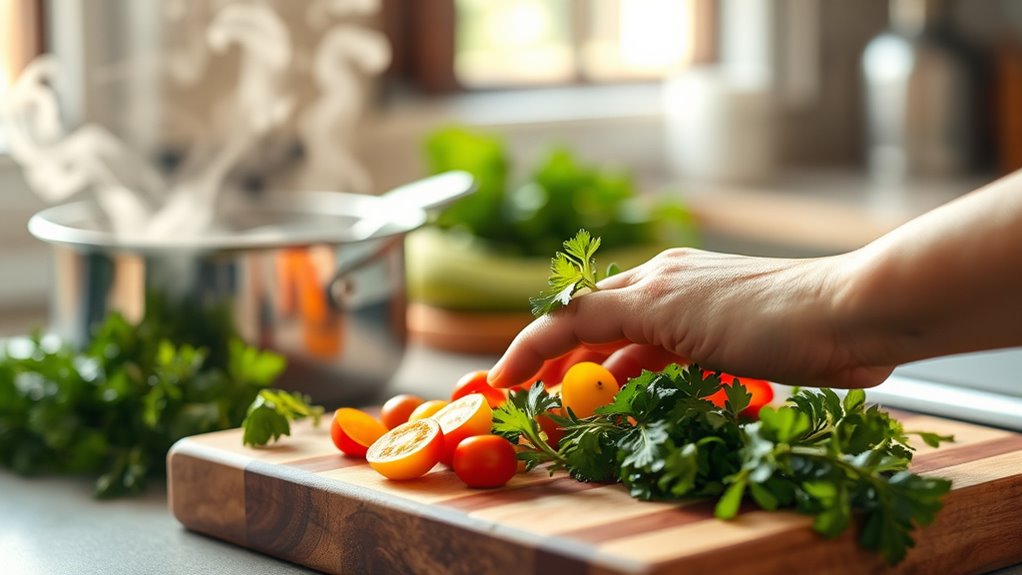Culinary mindfulness turns cooking and eating into calming, meditative practices by engaging your senses fully. As you focus on textures, aromas, and sounds, you slow down and become more present in each moment. Noticing the effort behind your food deepens your appreciation, while mindful breathing enhances relaxation. By paying attention to every step, you bring calm into your routine. To learn how integrating these mindful habits can transform your experience, keep exploring further.
Key Takeaways
- Practice mindful cooking by paying attention to textures, sounds, and scents at each step to deepen sensory awareness.
- Slow down during meals to savor flavors, aromas, and contrasts, turning eating into a meditative experience.
- Focus on the effort behind food preparation to foster gratitude and a respectful connection with what you consume.
- Incorporate deep breathing and pauses between bites to enhance presence and promote relaxation during eating.
- View cooking as a calming ritual that nurtures mindfulness, body awareness, and overall well-being.

Have you ever paused to truly savor each bite of your meal? It’s easy to rush through eating, distracted by screens or thoughts, but intentional mindfulness transforms this everyday act into a calming practice. When you slow down, you become more aware of the textures and flavors that make each dish unique. Savoring textures means paying close attention to how food feels in your mouth—crunchy, chewy, silky, or tender. Instead of swallowing quickly, take time to notice the contrast between a crisp vegetable and a creamy sauce. This heightened awareness deepens your appreciation for the effort behind each ingredient and heightens your sensory experience.
A key element of culinary mindfulness is aroma awareness. As you prepare and eat, focus on the scents surrounding your food. Smell each ingredient as it’s cooked, noticing how the aromas shift and develop. Breathe deeply to fully experience these fragrances, which can evoke memories or create a sense of comfort. By consciously paying attention to aroma, you connect more deeply with the present moment and enhance your overall eating experience. This awareness transforms eating from a mindless act into a meditative practice.
Incorporating these mindful techniques into your cooking routine doesn’t require extra time or elaborate steps. It’s about shifting your focus—being present with each step of preparing and eating. When chopping vegetables, notice the texture of the produce; feel the firmness or softness. When stirring a sauce, listen to the sizzle or bubbling, and smell the spices as they release their aroma. During the meal, pause between bites to observe the textures and scents anew. This practice helps slow your mind and body, turning a simple meal into a moment of meditation.
Practicing culinary mindfulness also encourages gratitude for the food you eat. Recognizing the effort involved—from farm to table—fosters respect and appreciation. As you become more aware of textures and aromas, you may find yourself eating more slowly, which can support digestion and prevent overeating. It’s about creating a connection—not just with your food, but with yourself. This mindful approach turns everyday eating into a nourishing ritual that cultivates presence, calmness, and a deeper enjoyment of life’s simple pleasures. Additionally, embracing culinary mindfulness can promote better digestion by encouraging slower, more attentive eating habits.
Frequently Asked Questions
How Can Culinary Mindfulness Improve Overall Well-Being?
Culinary mindfulness can profoundly boost your overall well-being by encouraging you to focus on each step, from mindful ingredient selection to creating a calming cooking environment. When you pay attention to the senses and stay present, you reduce stress and increase gratitude for your food. This practice nurtures mental clarity and emotional balance, making cooking a therapeutic activity that enhances your physical health and promotes a sense of inner peace.
What Are Simple Techniques to Start Practicing Mindfulness While Cooking?
Imagine your kitchen as a peaceful garden where each task is a gentle breeze. To practice mindfulness, focus on simple techniques like mindful chopping, paying attention to the sensation and sounds. Engage your senses fully—smell, sight, and touch—while cooking. This helps you stay present and reduces stress. Start with small steps, like savoring each ingredient’s aroma, and gradually build your awareness to enjoy cooking more fully.
Can Culinary Mindfulness Help With Emotional Eating or Stress?
You might find that practicing mindful snacking and increasing emotional awareness can help reduce emotional eating and stress. When you pay close attention to your body’s hunger signals and your feelings, you become more aware of triggers that lead to overeating. By slowing down and savoring each bite, you create a calming routine that fosters emotional balance. Culinary mindfulness encourages you to connect with your food and emotions, promoting healthier habits and stress relief.
How Does Mindful Cooking Influence Taste and Food Appreciation?
Did you know that mindful cooking can boost your flavor perception by 30%? When you focus on each step, you enhance your sensory experience, leading to greater appreciation of food. By paying close attention to textures, aromas, and tastes, you deepen your connection with your meals. This sensory enhancement not only makes eating more enjoyable but also encourages healthier choices, transforming cooking into a mindful practice that fosters gratitude and culinary curiosity.
Are There Specific Cuisines Better Suited for Mindfulness Practices?
Certain cultural cuisines are particularly suited for mindfulness practices because their meditation techniques emphasize slow, intentional preparation and savoring. For example, Japanese cuisine often encourages mindful, precise techniques that foster presence. Indian and Middle Eastern cuisines also incorporate rituals that promote meditation through spices and spices blending. You can deepen your culinary mindfulness by exploring these cultural cuisines, allowing you to connect more fully with the sensory experience of cooking and eating.
Conclusion
By embracing culinary mindfulness, you transform cooking into a calming, meditative practice that nurtures your mind and body. Did you know that practicing mindful eating can reduce stress levels by up to 40%? So next time you cook, slow down, focus on each step, and savor the moment. Turning your kitchen into a space for mindfulness not only enhances your dishes but also brings peace into your daily life.









